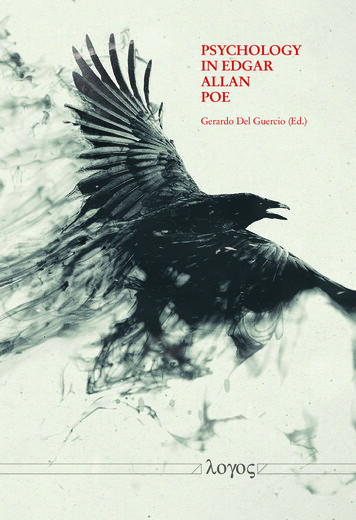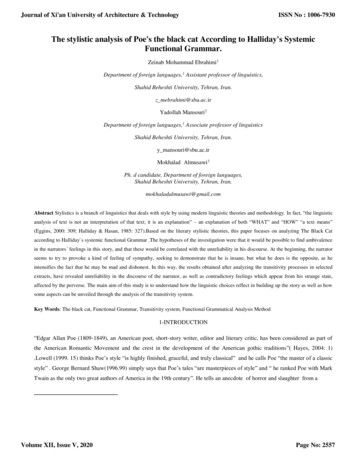
Transcription
PSYCHOLOGYIN EDGARALLANPOEGerardo Del Guercio (Ed.)λογος
Psychology in Edgar Allan Poe
Psychology inEdgar Allan PoeGerardo Del Guercio (Ed.)Logos Verlag Berlinλογος
Bibliographic information published by Die Deutsche BibliothekDie Deutsche Bibliothek lists this publication in the DeutscheNationalbibliografie; detailed bibliographic data is availablein the Internet at http://dnb.ddb.de.The electronic version of this book is freely available under CC BY-SA4.0 licence, thanks to the support of libraries working with KnowledgeUnlatched (KU). KU is a collaborative initiative designed to make highquality books Open Access for the public good. More information aboutthe initiative and links to the Open Access version can be found atwww.knowledgeunlatched.org.Logos Verlag Berlin GmbH, 2019ISBN 978-3-8325-4940-4DOI: 10.30819/4940Logos Verlag Berlin GmbHGeorg-Knorr-Str. 4, Geb. 10D-12681 BerlinGermanyphone:fax: 49 (0)30 / 42 85 10 90 49 (0)30 / 42 85 10 92http://www.logos-verlag.com
ContentsIntroduction7G ERARDO D EL G UERCIO1Poe and the Contemporary Serial Killer Narrative13K AREN J. R ENNER2Perverse Selves: Unwanted Impulses and Obsessionin Poe41R ACHEL M C C OPPIN3Staging Nothing:The Figure of Das Ding in Poe’s “The Raven”67S EAN J. K ELLY4The Doppelgänger, Psychology, and Poe101TATIANA P ROROKOVA5All Things in Heaven and Earth:The Ethics of Vision in “The Tell-Tale Heart”121P HILLIP G RAYSON6Mapping German Poetics onto the American Psyche:Masculinity and Metaphysics from E.T.A. Hoffmannto Edgar Allan Poe139G ERARDO D EL G UERCIOAbout the Contributors1635
IntroductionG ERARDO D EL G UERCIOThis volume presents recent critical work on Edgar Allan Poe andpsychology. It began in 2012 after careful consideration of whatwas lacking in Poe scholarship. Upon months of combing througharchives at McGill University, Concordia University, as well asJSTOR I discovered that nothing on Edgar Allan Poe and psychology had come around in many years. After more considerationI posted a Call for Papers and received at least thirty responsesfrom scholars from all areas of the world. Finally, in August 2018I made a selection of the six manuscripts which reflect the currentattitudes toward Poe’s work and psychology.In the first chapter, Karen J. Renner examines how Edgar AllanPoe’s fictional confessions of murderers and his detective storiesprovided models for both the serial killer and the profiler respectively. Many of the primary characteristics of serial killers can betraced back to Poe, including their ability to blend in with “normal” society, the ways that the details of their seemingly motiveless murders contain clues to their psyches, and their so-called Godcomplexes. In addition, Poe himself and his detective Dupin haveserved as prototypes for the criminal profiler, the serial killer’simagined rival. Poe’s work may have even influenced actual serial killers by giving them a framework through which to understand—and perhaps even to model— their murderous desires.The book then moves to Rachel McCoppin’s “Shadow Selves: Unwanted Impulses and Obsession in Poe.” McCoppin advocatesthat Edgar Allan Poe’s works are defined by obsessed narrators.7
8Gerardo Del GuercioTheir obsessions are often baffling to readers: an “evil eye,” amerciless cat, or an identical twin, but what makes Poe’s narratives truly horrific is the sense that the narrators’ obsessions comefrom within. Poe’s narrators have lost touch of reality; they focus conflict within their own unconscious outward which creates irrational obsessions. Carl Jung declares that the unconsciouscan force the individual to come face-to-face with one’s true selfthrough obsessive means, and Poe’s narrators do just this. Thenarrators of “The Imp and the Perverse,” “The Tell-Tale Heart,”“The Black Cat,” “Berenice,” “Morella,” and “William Wilson” allreveal their unconscious obsession to unmask themselves, revealing a self that does not adhere to societal expectations.Sean J. Kelly intelligently examines, through a Lacanian psychoanalytic framework, the aesthetic effects of Edgar Allan Poe’s poem“The Raven” (1845), specifically those effects produced by thepoem’s sublime architectonics of present-absence. While criticshave examined the role of the sublime and uncanny in the poem,most of these studies have focused on providing an historical context for Poe’s aesthetics or establishing cultural sources for thepoem’s symbolic imagery. By contrast, Kelly aims to demonstrate that both the form and content of “The Raven” anticipatethe psychoanalytic, specifically Freudian-Lacanian, concept of dasDing—the mythical “Thing”—which Jacques Lacan, in SeminarVII, argues is the lost object “attached to whatever is open, lacking, or gaping at the center of our desire.” Because, according toLacan’s theory, this concept names the void around which humansubjectivity forms and all subsequent desire turns, art functions,in essence, to “creat[e] the void and thereby introduce[e] the possibility of filling it.” In this essay, Kelly examines both how thevoid is staged through aesthetic means in “The Raven” and “filled”by the enigmatic raven, which takes on the function of a sublimeobject in the speaker’s melancholic fantasy. This article is used bypermission of The Pennsylvania State University Press.” I shouldlike to acknowledge The Edgar Allan Poe Review for granting copyright permission to reuse “Staging Nothing: The Figure of Das
Introduction9Ding in Poe’s ‘The Raven,’ ” which appeared in The Edgar AllanPoe Review, Vol. 17, No. 2, 2016, pages 116-141.Tatiana Prorokova’s chapter “The Doppelgänger, Psychology, andPoe” demonstrates how already in the mid-nineteenth century,one of the most famous “Dark Romantics” Edgar Allan Poe meticulously examined the problem of human mind in his short stories.Investigating the connections between one’s behavior and the psyche, Poe undoubtedly became one of the pioneers of psychology.While literally each story written by Poe deals with the problem ofhuman psyche, this chapter focuses on four of his works, namely“The Black Cat,” “The Tell-Tale Heart,” “The Fall of the Houseof Usher,” and “William Wilson,” to analyze the issue of the doppelgänger as represented in Poe’s oeuvre. Apparently, the existence of the dichotomy of the “good” self vs. “bad” self, whichinevitably results in the split of one’s personality, was one of theissues from human psychology that interested Poe. Criticizingthe notion of human perfection and exploring the questions of sinand self-destruction as an inherent part of the human nature, Poe’sstories question human morality, overtly hinting at the depravityof individuals and society in general as well as undermining thesanity of human mind. Thus, the chapter explores the characters’ doppelgängers that Poe’s stories introduce to their readers tounderstand the problem of one’s psychological mutilation and itsvarious manifestations.In “A Hideous Veil,” Phillip Grayson argues that Edgar AllanPoe’s “The Tell-Tale Heart” is a story about how the mind recognizes the reality of other people, and ultimately of the world.Grayson finds in the story a striking demonstration of the cognitive processes that connect us to others and to the world aroundus. The darkness of the solipsism of a world known only superficially, sensorily, cut off from the reality of the minds of others.Central to these processes is a concept called extramission. Extramission is the idea that vision is accomplished by emitting someforce or substance from the eyes. While scientifically inaccurate,this idea has been perennially and universally popular, seen in fig-
10Gerardo Del Guercioures from Medusa to Superman, and undergirding folklore andancient anatomical systems alike. The key to extramission’s persistent appeal is that it reveals a key aspect of the consciousnessesof others, allowing us to track their attention and recognize theirexistence outside of ourselves. Nowhere is this more evident thanin “The Tell-Tale Heart.” Here, the inhuman eye of the narrator’sbenefactor eventually drives the narrator to murder. This penultimate chapter argues that the failure of the old man’s eye to revealhis inner consciousness, its failure to emit some energy or material to confirm the inner life of the old man, lies at the heart of thenarrator’s murder, and allows the story to explore ways in whichwe experience reality and the importance of these experiences.Written by the volume editor, “Mapping German Poetics ontothe American Psyche: Masculinity and Metaphysics from E.T.A.Hoffmann to Edgar Allan Poe” argues that the German influenceon Edgar Allan Poe was indeed essential in his formation of theshort story form that arguably best maps out the motions andpoetics of the mind freed from the divisions between language,sensation, and elevated perception and not merely a doppelgängerper se. It is Poe’s attempt to venture into borderlands of the creative process that is designed to bridge the gap between hyperrational poetics and metaphysical speculations. Mesmerized bythe malleability of the material world to imaginative faculties, Poeadapts Hoffmann’s dualist stories dealing with the “feminine inmen (that) inevitably results in destruction or a life half lived”even further to create a space where unifying forces replace thenew psychological language of a woman’s creative energies as wellas traditional notions of the doppelgänger motif.The intention of the particular layout of this book is not to suggestthat the chapters be read in any particular order. Chapters shouldbe consumed in the order that helps most readers understand theassociation between Poe and psychology. Taken together, eventhough we are one hundred and seventy years after Poe’s death, hiswritings and world are still very much alive. The various interpretations of Poe and Psychology presented in these essays highlight
Introduction11the richness, complexity, and pertinence of this classic author. Aspecial gratitude to my contributors for donating their abstract tothe present Introduction.
1 Poe and the Contemporary SerialKiller NarrativeK AREN J. R ENNERAuthors and filmmakers have long envisioned natural connectionsbetween Edgar Allan Poe and the serial killer, although his role inthose texts varies. On the one hand, Poe is the serial killer’s darkmuse, his writings offering inspiration to the homicidally inclined.In the first season of the television show The Following (2013-), forexample, Poe’s works inspire the macabre murders of a modern serial killer. Joe Carroll (James Purefoy), an English professor, killsa string of victims, taking cues from the works of his beloved Poe,but his homicidal reign does not end when he is brought to justiceby his nemesis, FBI agent Ryan Hardy (Kevin Bacon), for Carrollmanages to recruit a group of followers (hence the show’s title)to carry out crimes he concocts while in prison. Carroll and hisminions give clues regarding their next acts of violence throughcoy references to Poe, forcing Hardy to take on the role of literarycritic in addition to detective in order to foil their plans. Othertexts focus on the murders Poe wrote, imagining them as inspiringactual murders. A fictional killer commits crimes that resemblePoe’s stories in William Hjortsberg’s Nevermore (1994), prompting Harry Houdini and Arthur Conan Doyle to join forces totrack down the killer (though Poe’s ghost plays a part as well). Inaddition to serving as muse to fictional serial killers, Poe has beencited as inspiring at least one actual one as well: in a documentary entitled H. H. Holmes: America’s First Serial Killer, he is citedas an influence for the crimes committed by Holmes in GildedAge Chicago: at one point, the narrator of the documentary omi13
14Karen J. Rennernously exclaims, “As others received inspiration from Rockefellerand Carnegie, H. H. Holmes drew his dark desires from the torture chambers of Edgar Allan Poe.”1On the other hand, Poe is also imagined to be the serial killer’sconsummate nemesis, a skill he has no doubt gained in the cultural imaginary by fathering the mystery genre. For instance, inthe 2012 film The Raven, a serial killer is on the loose in 1840sBaltimore, committing a series of slayings that resemble the mostgruesome of Poe’s stories. The first murder involves two victims—a young girl whose body has been stuffed up a chimney andher practically decapitated mother—as well as a window that openswhen a hidden spring is activated; the text referenced is clearly“The Murders in the Rue Morgue.” During the next homicide, aman is strapped to a table while an elaborate mechanism of gearscauses a blade to slash back and forth in the air above his stomach, slowly lowering until it slices the man in half; the obviousmodel for this murder is Poe’s “The Pit and the Pendulum.” Aspolice realize the connections between these gruesome murdersand Poe’s short stories, Poe himself (played by John Cusack) isbrought on to help the police predict the next crimes that thekiller plans to commit. Other contemporary works also imaginePoe as accomplished detective. In Batman: Nevermore (2003), forexample, Poe pairs up with the Dark Knight to solve a string ofmurders in nineteenth-century Baltimore. In Harold Schechter’sseries of novels (Nevermore: A Novel [2000], The Hum Bug [2002],The Mask of the Red Death [2004], The Tell-Tale Corpse [2006]), Poeworks alongside other notable nineteenth-century figures, such asP. T. Barnum, Davy Crockett, and Louisa May Alcott, to solvevarious murders.Poe’s imagined detective genius seems to be partly a result of hisown dark leanings: the belief is that he can track down the serialkiller because on some level he thinks like him. The descriptions1H. H. Holmes: America’s First Serial Killer, directed by John Borowski (2004;Toronto, Ont.: Waterfront Productions), Netflix.
Poe and the Contemporary Serial Killer Narrative15of Schechter’s novels on his website, for example, portray Poe asa tormented and troubled man. The synopsis for Schechter’s Nevermore pictures Poe “plagued by dreadful ruminations and horrific visions” while the summary of Hum Bug imagines that “hisrealm of terror lies in the shadows of imagination.”2 It is preciselyPoe’s supposed ability to empathize with disturbed men that, combined with his skills of detection, allows him to successfully trackdown serial murderers. Poe’s affiliation with the dark side is, ofcourse, largely a fabrication initiated by Rufus Griswold’s unflattering 1849 obituary and perpetuated by critics and fans ever since.Mark Neimeyer writes, for example, that “Poe has largely beentaken up by popular culture because of its ability to exploit hispersonal suffering and the sad, and sometimes strange, realities ofhis life as well as the even more fantastic myths that have grown uparound him. Poe has become the archetype of the mad genius orthe tortured Romantic artist.”3 As Caleb Puckett puts it in “TheMan of the Crowd: Following Poe and Finding Evil in PopularCulture,” artists (and readers) connect not only to Poe’s works butalso “to the image of Poe himself in the role of shadowy, artisticgenius who is tortured by his awareness of evil and his own vices”(77).The image of Poe as haunted by and highly conversant in thedarkest realms of human nature is largely an outcome of the twogroups of texts he wrote in the 1840s. During that decade, Poepublished three fictional first-person confessions of murderers sosimilar in style and plot that they read almost like three variationsof a single story: “The Tell-Tale Heart” (1843), “The Black Cat”(1843), and “The Imp of the Perverse” (1845).4 All three feature an234“Nevermore: A Novel,” nd “The Hum Bug,” http://haroldschechter.com/books/hum-bug.“Poe and Popular Culture,” 209.While “The Cask of Amontillado” would also seem to fit into this category, itdiffers in some important ways. For one, its first-person narrator, Montresor,has a more commonplace motive for killing Fortunato: Fortunato has insultedhim in some undisclosed way that Montresor feels warrants his death. Moresignificantly, Montresor gets away with murder, and therefore his confession
16Karen J. Renneranonymous narrator who kills an equally anonymous victim withwhom he is intimate on some level but for whose death he exhibits little remorse. The motives they offer for their murders areunclear, unconvincing, or, in the case of “The Black Cat,” downright questionable. In each story, the narrator attempts to hide thecrime—the narrator of “Imp” makes the murder look like a naturaldeath while the other two narrators simply hide the bodies—buteventually each ends up revealing his homicide in some way. During the same decade, Poe also wrote the three tales that would birththe mystery genre: “The Murders of the Rue Morgue” (1841),“The Mysteries of Marie Rogêt” (1842), and “The Purloined Letter” (1844). The protagonist of these stories, C. Auguste Dupin,a largely armchair sleuth who solves crimes that stump the policesimply for the pleasure of it, would later serve as a model for manydetectives to come. Together, these two sets of stories and theircentral figures—the murderer and the investigator—have come torepresent the two faces of Poe: the madman and the genius.In this essay, I wish to uncover the impact that Poe’s work andpersona have had on the way serial killers are constructed in bothmedia and fiction and quite possibly even the ways in which actual murderers have understood their own identities and acts.5 Iargue that many of the primary characteristics of the fictional serial killer can be traced back to Poe’s works, including his abilityto blend in with “normal” society, the ways that the details of hisseemingly motiveless murders contain clues to his psyche, and hisso-called God complex. In addition, Poe himself and his detectiveDupin, I claim, have served as prototypes for the criminal profiler,the serial killer’s rival. Often, the profiler’s proficiency at tracking down killers is due to his ability to empathically enter intotheir dark mindsets—a skill that both Dupin and supposedly Poe5lacks the self-destructive quality of Poe’s other stories; his crime seems more ofa triumph committed for reasons he finds logical, and so he has little to explain.For a discussion of Poe’s impact on true crime narratives, see Christine A. Jackson’s The Tell-Tale Art: Poe in Modern Popular Culture (Jefferson: McFarland,2012).
Poe and the Contemporary Serial Killer Narrative17himself readily display. This emotional capacity frequently marksthe profiler as a morally ambiguous character, either corrupted byexposure to evil or already somewhat depraved to begin with, inmuch the same way that Dupin is portrayed as morally and emotionally questionable and Poe as a man tormented by the darknessof his own mind.The fictional serial killer narrative, which grew in popularity during the last quarter of the twentieth-century, was not the spontaneous brainchild of popular culture but rather took its inspirationfrom the true crimes committed by actual twentieth-century serialkillers, who grew in number to such a degree that it sparked a veritable panic. These men, I will argue, could very well have beenshaped by Poe’s texts as well. A surprising number of them wereborn in the middle of the twentieth-century and educated in subsequent decades, at the exact time that Poe’s prose—and particularlythose murderous confessions—superseded his poetry in Americanliterature anthologies and high school curricula. While I wouldnever go so far as to blame Poe for turning men into serial killers,it is possible that his works shaped the ways in which men already predisposed to violence have understood their impulses andactions. Thus, Poe’s connection to the serial killer narrative istwofold. In addition to inspiring the creators of serial killer fictions, he may have influenced the very real men responsible forthe genre in the first place.Poe and the Serial Killer NarrativeAlthough official agencies, such as the FBI and National Instituteof Justice (NIJ), specify slightly different criteria, a serial killer isgenerally understood to be someone who “murders at least twopeople in distinctly separate incidents, with a psychological restperiod between.” In addition, the murders typically are neitherreactive nor committed with a particular goal in mind but appear
18Karen J. Rennerto be “satisfying act[s]” in and of themselves.6 Although actualserial killers vary quite widely, the image that has seized the popular imagination is of a white man of above average intelligencewho kills strangers for deeply personal reasons often related toearly childhood experiences; the details of their troubled psychology are symbolically embedded in the consistent features of theirmethodology.Technically speaking, then, Poe did not write about serial killers,for neither the crimes that Dupin investigates nor the homicides committed by Poe’s murderers fit the definition. “ThePurloined Letter” does not even contain a killing, the culprit in“Rue Morgue” is revealed to be an orangutan, not a man, andthere is only one victim in “Marie Rogêt.” In the confessions,only one homicide occurs, and the victims are no strangers totheir murderers, as is commonly the case with the targets of serialkillers, but, on the contrary, are acquaintances of some sort, ifnot housemates. The terms that we use—psychopath, sociopath,antisocial personality, serial killer— are twentieth-century inventions as the figure itself largely appears to be. In Serial Killers:Death and Life in America’s Wound Culture, Mark Seltzer claims,“Serial killing, by all accounts, became a career option at the turnof the century.” Philip Jenkins similarly notes that FBI data suggests “that recorded serial murder cases have accelerated rapidlyover time, with the mid-1960s as the crucial turning point in thistrend.” Fictional serial killer narratives increased in response tothe dramatic rise in actual crimes of this type; Philip L. Simpsondates the subgenre as beginning in “the late 1970s or early 1980swith the coinage and widespread dissemination of the term ‘serialmurder.’ ”7 Simply put, Poe could not have written about serialkillers because they didn’t exist yet, at least not in their commonform.67Katherine Ramsland, xi.Seltzer, 1; Jenkins, Using Murder, 29; Simpson, Psycho Paths, 14; Jenkins, 2.
Poe and the Contemporary Serial Killer Narrative19Although Poe’s writings predate the “discovery” of the serialkiller, people with similar brands of mental illness were beginningto be “officially” identified as early as the mid-nineteenth century,when Poe was writing. At that time, though, they would havebeen diagnosed with “moral derangement” or “moral insanity.”In fact, when Poe was writing his tales, a debate was raging overwhether the insanity plea should be expanded to include peoplediagnosed with these mental illnesses. Poe himself was very interested in the subject, even serving, as Paige Matthey Bynum pointsout, as “a trial reporter in the 1843 murder-by-reason-of-moralinsanity trial of James Wood.”8 In delving into the minds of themorally insane, even if only in his imagination, Poe was amongthe first to fictionalize the act of criminal profiling and thus pavedthe way for the serial killer narrative.Certain aspects of Poe’s mysteries and murders are also starklysimilar to serial killer stories, both factual and fictional, as criticshave pointed out.9 One feature of the popularized notion of theserial killer that can be traced back to Poe’s work is his anonymityand unremarkable nature, his ability to blend into “normal” soci89Bynum, 145. Furthermore, just six months before the publication of “Imp,”the opening article of the North American Review was a 37-page piece devotedto the subject of insanity that used three texts as a springboard for its discussion: the second edition of Isaac Ray’s A Treatise on the Medical Jurisprudence ofInsanity; a report of the trial of Abner Rogers, Jr., a murderer who had beenacquitted by reason of insanity; and The Plea of Insanity in Criminal Cases byForbes Winslow, a British psychiatrist who would later gain notoriety for hisinvolvement in the investigation of the Jack the Ripper murders. Poe’s “Imp ofthe Perverse,” published a mere six months later, contains a paragraph whichalmost exactly duplicates a passage from this article, which suggests that Poenot only read this article but incorporated its ideas into his short story. SeeRenner, “Perverse Subjects.” See also John Cleman, Dan Shen, and ElizabethPhillips.Dennis R. Perry directly refers to Poe—and especially the versions of his storiespresented in 1940s films—as an “impetus for stories about serial killers” (157).In “Evolutions in Torture,” for example, Sandra Hughes draws connectionsbetween Poe’s “The Pit and the Pendulum” and the movie Saw. See also TonyMagistrale’s “Proportioning Poe: The Blurring of Horror and Detection in TheSilence of the Lambs.”
20Karen J. Rennerety. Poe captures this characteristic in two ways. First, he giveshis killers very few defining characteristics. In addition to beingunnamed, we have no idea what they look like or even where theylive. They are literally unidentifiable. Furthermore, their ability to at least momentarily escape suspicion suggests a knack forpantomiming normalcy, a talent that triggers a deep fear aboutour inability to detect dangerous individuals amongst the crowdsof strangers and even acquaintances that we encounter every day.Such a fear is conjured up by depictions of contemporary serialkillers as well, who are portrayed as able to wear a “mask of sanity” (so termed after a seminal book on psychopathy written byHervey Cleckley in 1941). As a white male between the ages of20 and 40, the average serial killer is also shrouded by what NicoleRehling describes as the “implied emptiness of white heterosexualmasculinity.”10 Contemporary accounts of serial killers emphasize their ability to blend in and remain undetected. An A &E documentary entitled The B. T. K. Killer Speaks, for example,begins with the question, “What could turn an ordinary, unassuming man into a monster?”11 Another describes Green RiverKiller Gary Ridgway as “unremarkable” and has one savvy expertexplain that Ridgway “looks and acts like everybody else and heacts and looks like nobody in particular, so he gets away withit.”12 Poe’s stories laid the groundwork for what would become aprominent contemporary anxiety about serial murderers, namelythat they walk amongst us unnoticed, a fear expressed effectivelyin the tagline for the film Disturbia: “Every killer lives next doorto someone.”One of the most important contributions that Poe made to theserial killer narrative is centering these stories on an understanding of motive. Although his Dupin mysteries are whodunits and101112“Everyman and No Man,” 245.“BTK Confession, Full Version,” https://www.youtube.com/watch?v BvWOje46Xp8.“Gary Ridgway — The Green River Killer - Documentary Films,” https://www.youtube.com/watch?v Z 9CHWKPWyE, 5:13, 5:20-27.
Poe and the Contemporary Serial Killer Narrative21howdunits, Poe’s confessions are whydunits. They begin with thekiller already apprehended and so lack the extended cat-and-mousegame between the uncaught killer and cop. What is left to detect,then, is not the identity of the murderer but his motives, both forcommitting and for confessing his crimes. Poe gives the readers ofhis confessions a mystery to solve, but it is one focused on psychological matters. The job of literary critic and forensic psychologistbecome intertwined.Many contemporary serial killer narratives force their audiencesinto a similar position, one that privileges comprehending thekiller over apprehending him. The reader/viewer is encouragedto take on this role through point of view. Unlike the police, whoonly know the killer through his crime scenes, the reader/vieweris often allowed to eavesdrop on the criminal and watch him notonly commit his gruesome crimes but also struggle with the cravings and consequences of his mental disturbance. For example, inThe Silence of the Lambs, we see Buffalo Bill carefully apply makeup, don a diaphanous gown, tuck away his penis and testicles, andlive out his fantasy of being a woman; the film allows us accessto behavior that provides clues about his motives for kidnappingand skinning women. The story of fictional serial killer FrancisDolarhyde, as presented in Thomas Harris’s prequel to The Silenceof the Lambs, Red Dragon (1981), follows a similar pattern, as do its1986 cinematic adaption Manhunter, its 2002 remake Red Dragon,and its revisit in season three of Hannibal. In fact, the practiceof alternating between scenes that update us on the progress ofthe criminal investigation and others that apprise us of the killer’smental condition and violent acts is key to the serial killer narrative, as is apparent, for instance, by its consistent use in the television show Criminal Minds (2005-). In the typical serial killernarrative, then, the viewer/reader knows who the killer is fromthe get-go, or, if not, then that knowledge proves inconsequential.Our primary task becomes understanding the killer’s psyche andwhy he is driven to commit such heinous acts of violence.
22Karen J. RennerWhile serial killer narratives today often point to the killer’s childhood as the cause of psychological disturbance, Poe’s stories forceus to take a more abstract approach, for he gives very little in theway of background to analyze. As a result, Poe’s killers often seembound by what they believe are higher purposes, killing for philosophical or even spiritual reasons. Almost fifty years ago, JosephJ. Moldenhauer described them as “inspired to kill” and as “practic[ing] a fine art of killing.”13 The narrators of both “Imp” and“Tell-Tale Heart” certainly present murder as a painsta
Ding in Poe’s ‘The Raven,’” which appeared in The Edgar Allan Poe Review, Vol. 17, No. 2, 2016, pages 116-141. Tatiana Prorokova’s chapter “The Doppelg anger, Psychology, and Poe” demonstrates how already in the mid-nineteenth century, one of the most famous










